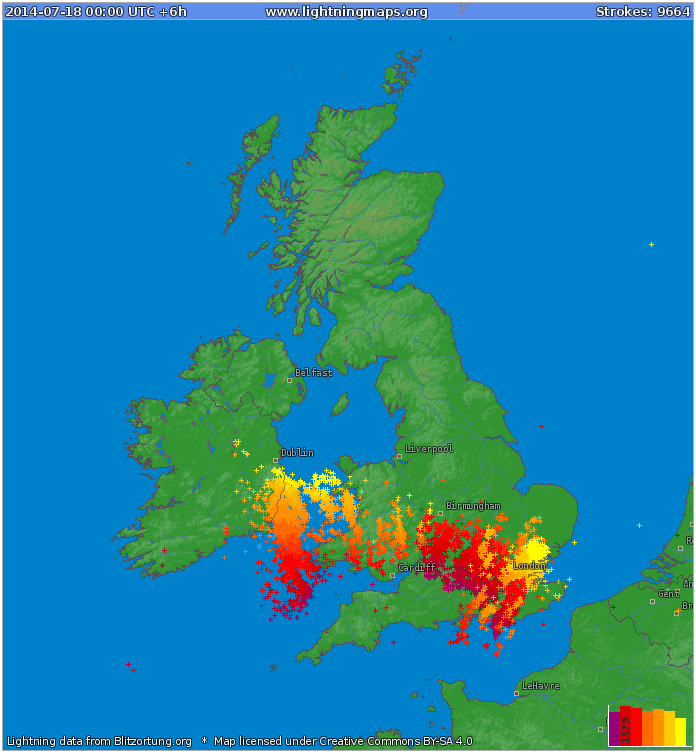OK, this is not strictly radio astronomy, though it does utilise the same VLF kit that we use to detect solar activity, so I think it's worthwhile posting here!
Over the last week, as we all know, we've had some pretty spectacular thunderstorms. As a result of this, I came across a website which enables you to track the location of electromagnetic discharges in the atmosphere (i.e. lightning discharges). The site is:
If you look at this site when there are thunderstorms about it is fantastic. The discharges are displayed within seconds of their occurrence, and it is possible to track the path of a thunderstorm over time. There is even an archive available, so you can look at historic data, and create animations of the storm. Really interesting to look at the storm which hit in the early hours of Friday morning (18 July):

This picture is from midnight to 6am. The yellow colours are the most recent strokes of lightning and the red colours are older.
All of this data is achieved by a network of detectors, consisting of an antenna system, a VLF amplifier, a controller board and a GPS receiver providing an 1PPS (one-pulse-per-second) signal.
A lightning discharge emits radio frequency energy over a wide range of frequencies; the most powerful are in the VLF range. Clearly, the advantage of low frequencies in contrast to higher frequencies is that these signals are propagated over thousands of miles by reflections from the ionosphere and the ground.
The VLF antenna is slightly different to the one we use for detection of solar activity, as it consists of more than one loop to cover all directions. They recommend two orthogonal crossed loops for a direction finding system.
All of the data is fed into the Blitzortung.org network, which seems to cover most of the world. According to Blitzortung.org "If you are interested to setup an own station then you can get the latest printed circuit boards and the programmed micro controller from us. If you are not from Germany, Austria, or Switzerland you can even get a complete controller kit, a complete amplifier kit, ferrite rod antennas, and a gps module for cost price, if desired"
Details on how to build a detector are here.
Thanks for the information Mike. Reading the above whetted my appetite, but going to the Blitzortung website and watching a thunderstorm move across Kris's home town in the US, in real time, WOW! It is a shame that the UK, in general, doesn't have a great deal of thunderstorm activity but, monitoring this site regularly might disprove this assumption?
Within the project introduction I found this comment in red:
"It is essential for a TOA lightning locating network that all participating stations behave exactly the
in the same way. Otherwise the computing accuracy will drop!"
So it would appear that a specialised antenna and receiver is required and our existing UKRAA VLF Receiver is not suitable. Checking out the list of participants it appears there are 4 in the UK. Could we interest the ROG in becoming the fifth?
I would be interested to look at.
So it would appear that a specialised antenna and receiver is required and our existing UKRAA VLF Receiver is not suitable
Damn, that's a shame.
Still, it looks like being a pretty cheap system to put together. I'll do a bit more investigation. With only 4 participants in the UK, it would be nice to persuade a few more to get involved... the ROG would be great, but I suspect any progress here will be, as usual, measured in geological time 😉
